How Are Diamonds Made? Natural vs Lab-Created Explained
Two Paths, One Diamond Not all diamonds come from the same place — but they all start the same way. Pure carbon, crystalized under immense pressure and heat. Whether it…
Updated: 3/7/2019
You already learned that cut is the most important factor affecting the beauty of a diamond.
The aim of this tutorial is to illustrate what it takes to achieve the ultimate in cutting precision and perfection – super ideal cut Hearts and Arrows diamonds.
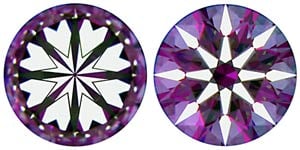

Before we begin, let us use the following definition: A diamond is a crystal, a prism that reflects light and disperses it. In other words this prism’s facets are two way mirrors that:
1. Reflect light or
2. Allow light to pass through them.
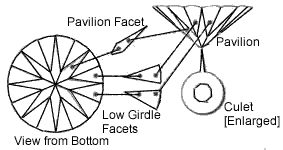

The rough diamond is prepared, sawed and the stone is brutted (made round). First 4 then 8 main facets are placed on the pavilion and the crown, and then the diamond is given its second cut again to make sure it is as round as possible. (No diamond can be absolutely rounded because the rough material has a hard side and a soft side). Because of diamond’s refractive index, the pavilion (bottom of the diamond that comes to a point) needs to be cut at an exacting angle. If there is some slight deviation from this angle, the diamond begins to leak light and this affects the light return. The relationship between the crown and pavilion is also very important. We will see this in detail later. Diagrammatic scheme of how a diamond is cut from the rough to the polished
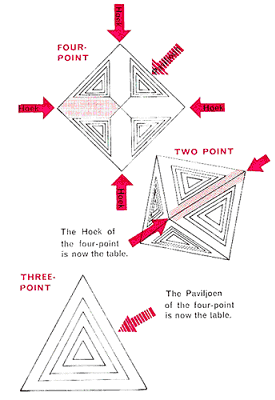
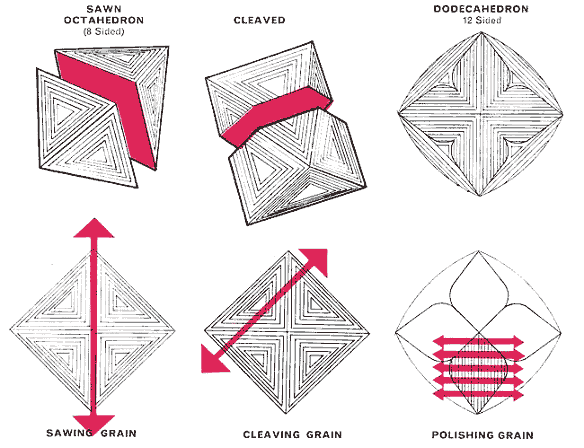
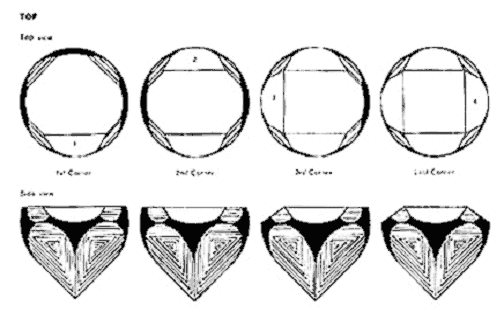

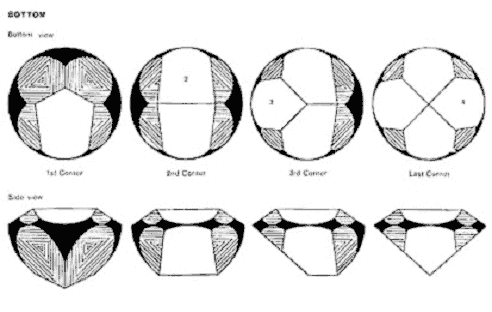

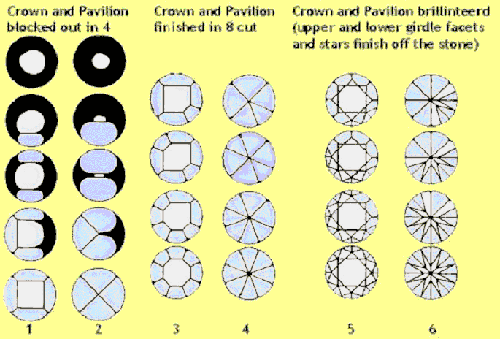
A view of the hearts and arrows forming during the cutting process through the Hearts and Arrows viewer.

1. The main pavilion facets outlined and one heart highlighted in red.
2. The main pavilion facet reflects on the opposite side.
3. It takes 4 facets to make one heart and one arrowhead on the pavilion and an additional 2 upper girdle facets to finish up and square off the tips of the rabbit ears of the heart.
4. This takes a total of 6 different facets. to create 1 Heart,-( 2 main pavilion facets and 2 Lower girdle facets and it is the 2 upper girdle facets that square off the bottom of the heart shape.) See pic.4-A: without upper girdle facets and pic. 4-B: with the upper girdle facets in place. Note the squared off heart shape.
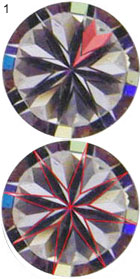
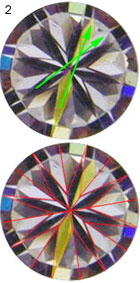
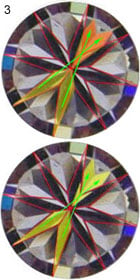

The labs grade symmetry according to meet point symmetry. The physical symmetry is made up of X,Y, and Z-axis which is what influences the optical symmetry. The optical symmetry will clearly show the physical symmetry being in or out of perfect harmony.
The lack of optical symmetry will be seen very clearly when viewing the diamond through the Hearts and Arrows viewer. It is easier to camouflage errors in the formation of the arrows, but it is impossible
to hide any inconsistencies in the heart pattern. In forming the arrows there are less facets to align so errors are more easily camouflaged, whereas in the hearts there are 6 facets that complete each heart
shape, and the slightest deviation is easily noticed.
As we have learned, the main pavilion facets are responsible for the formation of the hearts and now you will see its effect in causing the arrows pattern.
The shaft of the arrow is formed when one main pavilion facet reflects on the opposite main pavilion facet. The main crown facet allows a different view of the reflected main pavilion facet thereby forming the arrowhead.
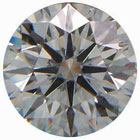
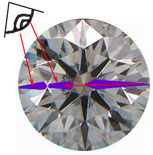
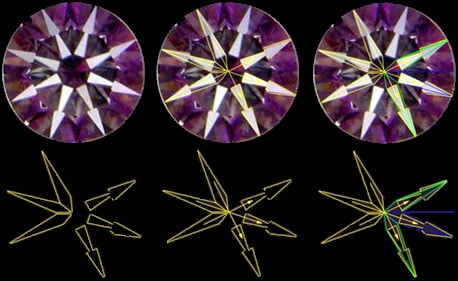
Quick Guide
In Detail and picture essay
1. First check to have 8 equal hearts and arrow heads.
They must be equal in size and shape as seen in the picture “True Hearts” Below you are shown a true set which are acceptable and a set Where the hearts are not quiet equal in size, but more importantly the hearts split in the cleft. This is a NO NO! (Not formed correctly this is the most difficult case of all to determine if it is correct or not)
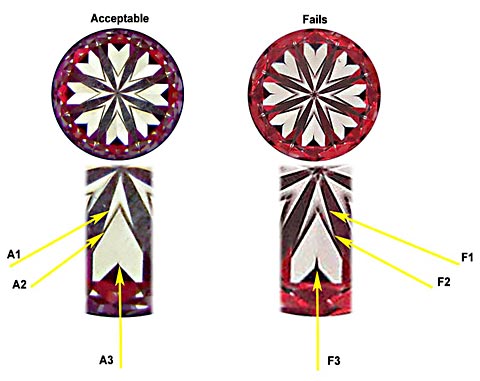
In A1, A2 and A3 the heart is well defined the gap between the Arrowheads is distinct and clear and the split at A3 is minimal versus F1, F2 and especially F3 where this is the case
2. Calculating the accuracy and Hearts you can measure the length as shown X_to_Y in 1a (A template tool can be used) say this is 10mm.Iif you see any splits in the cleft this is measured and it can be no longer than 8% of the total length of the heart as shown by Z to C in 2A if there are more than2 hearts split at more than 8% then it will not make the grade True Hearts, in addition the arrow head must separate from the actual Heart

WHAT HEARTS SHOULD NOT LOOK LIKE
Here are examples of hearts that do not make it and are easy to determine. Simply because they are not equal and homogenous and the arrowhead and hearts blend together in some cases.
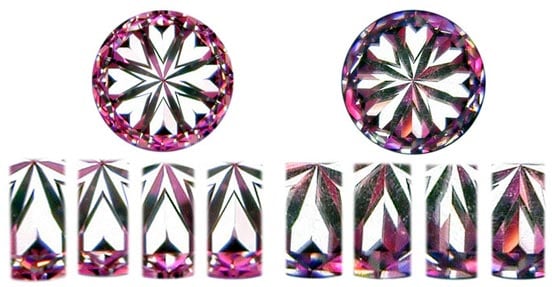
Here is a picture of an AGS0 cut AGS3706305 note that the hearts are splitting we can call them Variable V’s, also the Arrows heads and shafts are needle-like and not straight and are broken up.
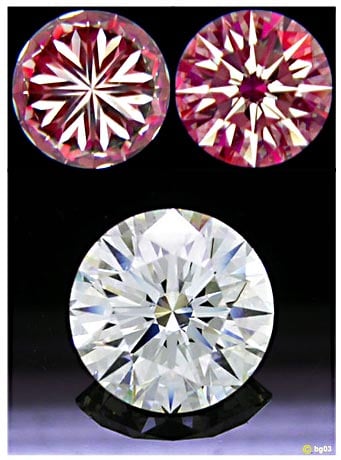
Checklist
This can be done visually once a standard of proficiency has been attained.
1. Each arrow (8) must be clearly visible with a shaft and a arrow head.
2. The 8 arrows shafts as well as heads have to be straight and in the right position.
3. The 8 arrow points must meet the girdle.
4. There must be total uniformity and balance.
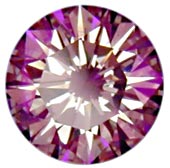
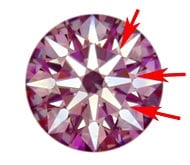
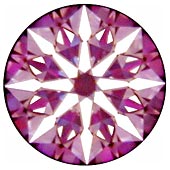
The Heart and Arrow pattern is analogous to all round stones, but if the diamonds have not been polished with super symmetry and well within the ideal parameters according to AGS standards, they will not be correctly defined. In addition, they take on a different form, shape and size.
Here is a comparative study of the patterning in stones. All the diamonds depicted here are 0.90 cts in weight they range from 0 to 7 on the AGS scale according to cut parameters.
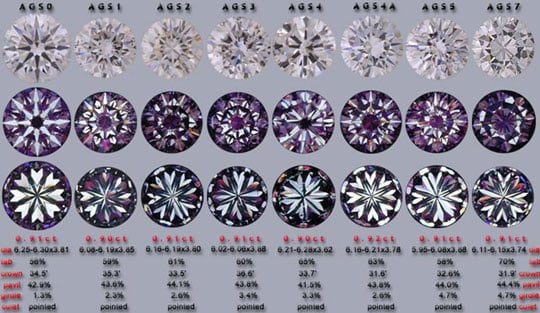
Phony Hearts and Arrows Diamonds
Just because a diamond is cut to ideal proportions with an AGS0 does not mean that it will exhibit a crisp and true hearts and arrows pattern. In addition to being ideal, the diamond has to have super symmetry – where all the angles and facets have to be perfect.

| Missing Hearts | Arrow heads or V-marks | Broken, split and different sized hearts, must be equal and uniform | No gaps between hearts and V-marks or arrow heads | Perfect Hearts |
| Missing Arrows | Poorly formed arrows no definition | Crooked shafts misshapen arrow heads | Missaligned arrow heads with shaft | Perfect Arrows |

Today Sarin and Ogi instruments are used to read and analyze measurements, angles and percentages. This is not a method to indicate the perfection of cutting. These machines show the perfection of the engineering in the equipment and the maintenance of the equipment.
Today’s cutting equipment is a lot more exacting. What is more important is that the equipment is in good condition and that the cutting plate skyf (pronounced skife like knife) and tang (tool to hold the diamond) are true and level (Fig. 1b) with each other so that there is very little deviation in the measurements when the stone is completed. The larger the stone the more visible this deviation can possibly be.
Note in Fig. 1a that the cutter can dial in the angle for the main pavilion or crown angles for the process of blocking out the stone in 8 cut. As you can see this is not entirely up to the cutter but also the engineers from the maintenance dept.
The precision of the cutter is really seen in the brillanteering (polishing on the lower and upper girdle facets as well as the stars) of the stone. This is where the craft comes into today’s diamond cutting world, the finishing of the stone the upper and lower girdle facets (half’s) and the stars. It is here where we have to rely entirely on the cutter for his mastery.
The Sarin and Megascopes are not measuring all these other angles at present, but the precision an consistency of these angles would reveal how great the cutter is. One method which reveals this all is by looking through the H&A scope at the hearts, one can see the precision and consistency of the cutting.
The antithesis of this is when a master diamond cutter swindles a stone, meaning he recovers the maximum possible weight and makes a lively stone. The angles; measurements and percentages will deviate by much on this stone, compared to a superideal. The Sarin machine will not show this mastery in the cutting but deviation yes. This machinery dose not prove how perfectly the stone has been cut. There is still one simple method above all the sophisticated MACHINERY and that’s the heart and arrow scope. If the machinery were to measure no deviation in other words if each angle was exactly the same one would view a diamond that would look dull to the eye much like a tympani drum, if one plays it in the center the sound is not good at all compared to when it is beat off to the side.
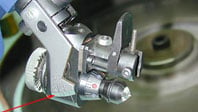
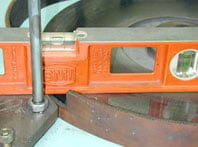
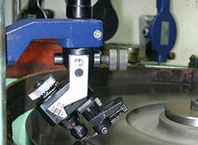
Conclusion
We found a careful balance must be maintained between
1. Angles (balance between Crown and Pavilion)
2. Consistency of Heart pattern (3D symmetry also known as optical precision)
3. >Symmetry (external meet point symmetry)
4. Excellent or Ideal polish with outstanding luster.
The result of true hearts and arrows faceting precision is the perfect alignment of all corresponding facets in three dimensions, optimizing the light handling capabilities of the facet design. Maximizing light performance through uncompromising precision has been the mission of A CUT ABOVE® diamonds from the beginning.
July 2001Whiteflash
